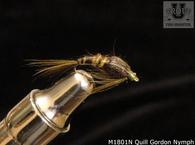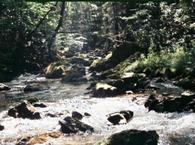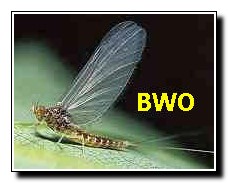 I recently did a description of the Penns Creek in Pennsylvania and that leads me to discuss the nature of the Blue Winged Olive mayfly. It is my opinion, that the Blue Winged Olive is the “universal” mayfly because it is found in just about every trout stream in the USA. Also, the hatch occurs over a much longer period of time than most of the mayfly family. In both the Eastern and the Western portions of the USA, they hatch sporadically through the year starting as early at the warmer days of winter and continuing to hatch through the fall season as well. During this time, there may be even more than one generation of the insects hatching. Most importantly to anglers is that the many species of the Blue Winged Olives make up a good deal of the trout’s diet through the year. Among the species, the color does not vary much, however the size may vary greatly. As a rule, the late winter and early spring hatchesusually produce mayflies of a smaller nature than the hatches that occur during the warmer months of the year.
I recently did a description of the Penns Creek in Pennsylvania and that leads me to discuss the nature of the Blue Winged Olive mayfly. It is my opinion, that the Blue Winged Olive is the “universal” mayfly because it is found in just about every trout stream in the USA. Also, the hatch occurs over a much longer period of time than most of the mayfly family. In both the Eastern and the Western portions of the USA, they hatch sporadically through the year starting as early at the warmer days of winter and continuing to hatch through the fall season as well. During this time, there may be even more than one generation of the insects hatching. Most importantly to anglers is that the many species of the Blue Winged Olives make up a good deal of the trout’s diet through the year. Among the species, the color does not vary much, however the size may vary greatly. As a rule, the late winter and early spring hatchesusually produce mayflies of a smaller nature than the hatches that occur during the warmer months of the year.
Although they do not live in still water, they can be found in the quieter sections of water in the faster streams. Look for them in the eddies and along the banks where there is quiet water. In the hot summer months of July and August, the hatches slow down and they often occur from mid morning until late afternoon. However, as the cooler weather of October and November come upon us, the hatches will usually occur in the warmest time of the day starting around noon. Another characteristic of the Blue Winged Olive hatches is that they usually last longer on the cloudy overcast days than they do on the sunny days. In fact, stormy, rainy, snowy days usually produce the largest hatches. When a BWO hatch occurs they become the food of choice for trout and the trout will prefer them over even larger insects.
When the Blue Winged Olive nymphs are getting ready to hatch, they will need to change locations and change their behavior. They come out from their normal hiding places and become much more available for the trout to eat, as they swim to the surface and penetrate the surface film of the water. During this time, they become more readily available for the trout to eat. In calmer water, this process may take a little more time and this gives the trout a greater window of opportunity.
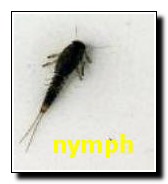 In the Blue Winged Olives hatch process, the appearance changes rapidly as their wings pop out of the wing case and they shed their nymphal shuck. The nymph is just starting to emerge and is more nymph than dun at this point. The fully developed dun will leave the water just as soon as the wings are dry enough to do so. This varies with the weather and water conditions but it only takes a very short time. The duns stay on the surface anywhere from a few seconds up to a minute or so, but that is all the time available for a trout to eat a fully emerged dun. They have more time to eat the Blue Winged Olives in the nymph stage and in the helpless emerging stage where they can not escape.
In the Blue Winged Olives hatch process, the appearance changes rapidly as their wings pop out of the wing case and they shed their nymphal shuck. The nymph is just starting to emerge and is more nymph than dun at this point. The fully developed dun will leave the water just as soon as the wings are dry enough to do so. This varies with the weather and water conditions but it only takes a very short time. The duns stay on the surface anywhere from a few seconds up to a minute or so, but that is all the time available for a trout to eat a fully emerged dun. They have more time to eat the Blue Winged Olives in the nymph stage and in the helpless emerging stage where they can not escape.
How do we anglers take advantage of this knowledge? Well, first the 1 or 2 weeks before a hatch is often overlooked but it can be a very important time in the transition as the nymphs become more available for the trout to eat than any other time in their life. The trout are well aware of that and feed heavily on these nymphs. In fact, the nymphs usually work even when flies are emerging. Trout seem to prefer eating the nymphs just prior to their emerging. Therefore it is wise to imitate the Blue Winged Olives as they are about to hatch and this is the time to use the
Perfect Fly Blue Winged Nymph.
However, if the hatch has already started, the trout can just sip the emergers that are floating in the surface film with little effort making this also an excellent time to fish. This is when the Blue Winged Olive Emerger is the fly of choice. The emergers are not designed to be fished in the fast water and they should be presented in the areas where the BWOs hatch. This usually takes a slightly longer cast with a lighter, longer leader and tippet. I would suggest a 9 foot, leader with at least a 2 foot, 6X tippet for the size 16 and 18 flies. There are situations (low water for one) where you may even need to use a 7X. Tip to remember: Emergers work very well at times, but when they are not very productive, you may do much better with the nymph pattern.
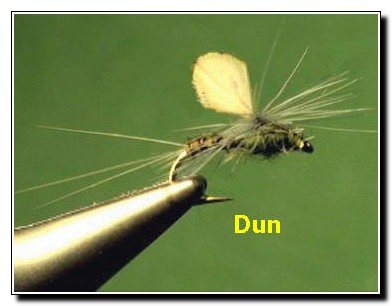 Imitations of the duns are much easier to see than the emergers because they float on top of the water. If the trout are feeding on the surface, the Blue Winged Olive dun is much more fun for the angler and this is the time to use the Perfect Fly Blue Winged Olive dun. Unlike the nymphs and emerger imitations, the duns should be presented in the current seams and at the ends of runs and riffles. By the time the emergers have shed their shuck, changed into duns and are on top of the water, they are usually caught up in the currents. Most of the time they are caught in the current seams where the slow water meets the fast water. This is often the edges of pockets. However, if you know a hatch is underway with the duns coming off the water, and the trout are not taking your dun imitation, it is may be more productive to swap to an emerger pattern.
Imitations of the duns are much easier to see than the emergers because they float on top of the water. If the trout are feeding on the surface, the Blue Winged Olive dun is much more fun for the angler and this is the time to use the Perfect Fly Blue Winged Olive dun. Unlike the nymphs and emerger imitations, the duns should be presented in the current seams and at the ends of runs and riffles. By the time the emergers have shed their shuck, changed into duns and are on top of the water, they are usually caught up in the currents. Most of the time they are caught in the current seams where the slow water meets the fast water. This is often the edges of pockets. However, if you know a hatch is underway with the duns coming off the water, and the trout are not taking your dun imitation, it is may be more productive to swap to an emerger pattern.
At Trout University our dun imitations are done in more detail making them more effective than other imitations simply because they are accepted by the trout more often than the other flies resulting in a higher percentage of takes. Refusals are rare especially in moderate or smooth water situations where the trout can get a good look at the fly. More on why to buy a Perfedt Fly. We hope that you will give them a try.
By the way, If you tie your own flies, our "Tying Perfect Mayfly Nymphs" DVD will show you how to tie the swimming nymphs as well as the other types of nymphs.
 I recently did a description of the Penns Creek in Pennsylvania and that leads me to discuss the nature of the Blue Winged Olive mayfly. It is my opinion, that the Blue Winged Olive is the “universal” mayfly because it is found in just about every trout stream in the USA. Also, the hatch occurs over a much longer period of time than most of the mayfly family. In both the Eastern and the Western portions of the USA, they hatch sporadically through the year starting as early at the warmer days of winter and continuing to hatch through the fall season as well. During this time, there may be even more than one generation of the insects hatching. Most importantly to anglers is that the many species of the Blue Winged Olives make up a good deal of the trout’s diet through the year. Among the species, the color does not vary much, however the size may vary greatly. As a rule, the late winter and early spring hatchesusually produce mayflies of a smaller nature than the hatches that occur during the warmer months of the year.
I recently did a description of the Penns Creek in Pennsylvania and that leads me to discuss the nature of the Blue Winged Olive mayfly. It is my opinion, that the Blue Winged Olive is the “universal” mayfly because it is found in just about every trout stream in the USA. Also, the hatch occurs over a much longer period of time than most of the mayfly family. In both the Eastern and the Western portions of the USA, they hatch sporadically through the year starting as early at the warmer days of winter and continuing to hatch through the fall season as well. During this time, there may be even more than one generation of the insects hatching. Most importantly to anglers is that the many species of the Blue Winged Olives make up a good deal of the trout’s diet through the year. Among the species, the color does not vary much, however the size may vary greatly. As a rule, the late winter and early spring hatchesusually produce mayflies of a smaller nature than the hatches that occur during the warmer months of the year.  In the Blue Winged Olives hatch process, the appearance changes rapidly as their wings pop out of the wing case and they shed their nymphal shuck. The nymph is just starting to emerge and is more nymph than dun at this point. The fully developed dun will leave the water just as soon as the wings are dry enough to do so. This varies with the weather and water conditions but it only takes a very short time. The duns stay on the surface anywhere from a few seconds up to a minute or so, but that is all the time available for a trout to eat a fully emerged dun. They have more time to eat the Blue Winged Olives in the nymph stage and in the helpless emerging stage where they can not escape.
In the Blue Winged Olives hatch process, the appearance changes rapidly as their wings pop out of the wing case and they shed their nymphal shuck. The nymph is just starting to emerge and is more nymph than dun at this point. The fully developed dun will leave the water just as soon as the wings are dry enough to do so. This varies with the weather and water conditions but it only takes a very short time. The duns stay on the surface anywhere from a few seconds up to a minute or so, but that is all the time available for a trout to eat a fully emerged dun. They have more time to eat the Blue Winged Olives in the nymph stage and in the helpless emerging stage where they can not escape. Imitations of the duns are much easier to see than the emergers because they float on top of the water. If the trout are feeding on the surface, the Blue Winged Olive dun is much more fun for the angler and this is the time to use the Perfect Fly Blue Winged Olive dun. Unlike the nymphs and emerger imitations, the duns should be presented in the current seams and at the ends of runs and riffles. By the time the emergers have shed their shuck, changed into duns and are on top of the water, they are usually caught up in the currents. Most of the time they are caught in the current seams where the slow water meets the fast water. This is often the edges of pockets. However, if you know a hatch is underway with the duns coming off the water, and the trout are not taking your dun imitation, it is may be more productive to swap to an emerger pattern.
Imitations of the duns are much easier to see than the emergers because they float on top of the water. If the trout are feeding on the surface, the Blue Winged Olive dun is much more fun for the angler and this is the time to use the Perfect Fly Blue Winged Olive dun. Unlike the nymphs and emerger imitations, the duns should be presented in the current seams and at the ends of runs and riffles. By the time the emergers have shed their shuck, changed into duns and are on top of the water, they are usually caught up in the currents. Most of the time they are caught in the current seams where the slow water meets the fast water. This is often the edges of pockets. However, if you know a hatch is underway with the duns coming off the water, and the trout are not taking your dun imitation, it is may be more productive to swap to an emerger pattern.


